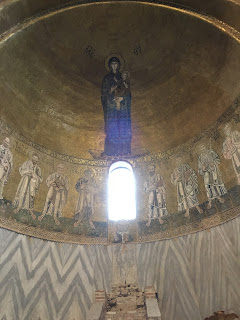New Old Journeys- Oxford
One of the very few and small consolations of the first lockdown of March 2020 was the exploration of local areas that, in normal times, one wouldn’t explore because of the pull of more celebrated cultural or recreational attractions. This was in the course of the permitted “household walk” of no more than hour (although that limit turned out to guidance rather than law).
Post lockdowns (but pre the next one?) there’s a kind of reverse experience to be had. This is the rediscovery of the once familiar – such as taking a train journey. And then, quite apart from the Pandemic, there’s always the revisiting of places not seen for many years, even though they have seemed to remain clear in memory, or imagination.
Such were the events of one day this September, when I made my tentative way to Marylebone Station, near Baker Street.
I’ve been using London buses a lot in recent months, and London Underground a bit. This was my first journey on a “normal” train since March 2020. I felt quite the novice at once: I didn’t know the mask rules or policy in the station or on the train (like most people, I played safe and masked).
I was on my way to Oxford for the day. The mainline train route is from Paddington, along the Thames valley, via Reading and Didcot. It is a fast, not very attractive, journey and was bound to be busy.
The slower journey from Marylebone involves a small, still attractive terminus, a very picturesque journey through Chiltern countryside, and was likely not to be crowded. There’s one caveat to the last expectation. “Bicester Village” is a stop on the way. It is a vast designer-luxury goods-discounter retail park. It has become a huge draw for tourists from China and the Gulf states. So much so, that the train’s screens and audio announcements play in in Mandarin and Arabic as the stop approaches.
I reckoned that tourism from those countries would still be at a relatively depressed level. I was half right. There were numerous Asian passengers for Bicester Village, but not so many as to crowd the train. (Returning later that day, the crowding threat was from commuting schoolchildren.)
The train terminated at Oxford. I now began a personal journey in psycho-geography. When did I last arrive in Oxford by train? 1970s or 2000s? I don’t remember; and certainly didn’t remember the monstrous bulk of the Said Business School which looms opposite the station entrance. The narrow pavement over the canal bridge into town was more familiar- but I don’t know from when last.
So to the Ashmolean museum – a familiar place at last, as I had visited in recent years a couple of times, arriving by bus from the northern Oxford Parkway station.
I was there to see Tokyo: Art and Photography. This exhibition was billed as an exploration of the city’s history through the art it has inspired. There were indeed many pieces of great quality, and some of less. But what was lacking for me, being largely ignorant of Tokyo and its history, was any strong historical theme. At the beginning of the exhibition one was greeted by a Timeline, showing the changes and catastrophes that have shaped or misshaped the city (the latter including earthquakes, fires and saturation bombing). But this wasn’t consistently pursued. I would have been grateful, for example, for a more expositional treatment of C20 militarism, military disaster and the rebuilding of modern Japan.
The most stunning display was early on, a wall devoted to outrageously beautiful and daring prints of Hiroshige. No wonder that he and Hokusai were inspirations for the European Impressionists and their followers.
Later, after a stroll reclaiming the old academic centre of the University (to which I did remember my last visits of 15 or so years ago, although my feelings on stepping to the quad of the Bodleian were not about any time of mine but the timelessness of the place), we wandered west to the district called Jericho, a network of streets of small houses pressing against the Oxford Canal, which slides from north to south towards its city terminus.
I can truly say that I had not been here for 50 years. I recognised nothing. It was strange. We visited the church of St Barnabas, built in the C19 in the midst of the Anglo-Catholic revival. It is a church the existence of which I was unaware.
The interior is a Byzantine shock. How this came about, I do not know. I was put in mind of the truly Byzantine church on Torcello in the Venice Lagoon, but was chastened to learn that some scholar had delivered a lecture on the comparison to St Barnabas only last winter (presumably on Zoom).
John Betjeman, Poet Laureate and architectural champion, wrote:
Good Lord, as the Angelus floats down the road,
Byzantine St Barnabas be Thine abode..
Then yet another experience of the new-found next to the familiar or rediscovered: the Oxford Canal towpath leading to a back way to the station. There is green and watery scenery (an impossible number of small waterways lurk between canal and the nearing River Thames), disturbed only by a posse of secondary schoolboys, out for an afternoon run, led by an apologetic young teacher.
I arrived back at Marylebone in the sunny warmth of late afternoon. I strolled to Camden through Regent’s Park – the gardens of the Inner Circle. This was another new experience, just outside the range of excursions permitted under that first lockdown.
October 2021








No comments:
Post a Comment